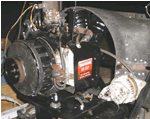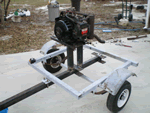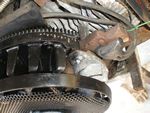
Example of engine damage possible
with lean burn or timing misadjustment
Click images for larger
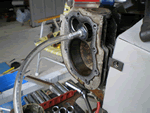
Valve lapping with hot glue
preheat bolt and valve with
propane torch, use tubing
and drill after cooled.
Detonation & Pre-Ignition Theory
Before reading this page, make sure that you have read the combustion dynamics page first.
Detonation
I have already explained what takes place within a combustion chamber where the gas burns at a uniform rate. Now lets see what happens when things go wrong. The picture below shows examples of microscopic melting increasing to physical chunks of the piston breaking away at the wrist pin. The pits are molten melting of the aluminum piston when the shockwaves scrub the protective boundary layer away from the metal parts. Notice that the most severe damage occurs at the edge of the piston where the shock waves reflect back.
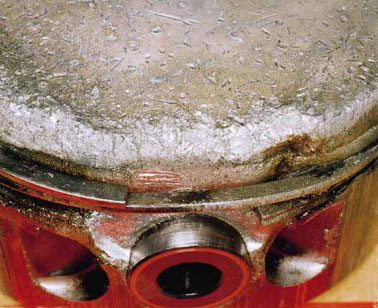
As you may recall, increased fuel octane will increase the temperature required for spontaneous combustion of the gas. But any gas will spontaneously ignite at some temperature. If the pressures and resulting heat generated by the combustion chamber reaches that spontaneous combustion temperature of the gas, havoc breaks loose within the combustion chamber, and the above picture shows the results.
With normal burn rates, the linear expansion of pressures are handled by the engine parts. This is because the energy expended by the burn is extended over a lengthy period of time (tens of crankshaft degrees). Detonation expends this energy all at once which creates a spiked compression pressure rise. This spiked pressure rise hammers against the piston top and combustion chamber walls, and makes that metallic hammer sound, sometimes referred to as a ping or rattle. Some forms of detonation make very little noise and cause very great damage.
This sudden release of energy has several down sides. First, it places severe stress on the engine parts. Secondly, it rapidly expends the burn energy of the gas so none is left for the rest of the power stroke, with most of the energy being spent as heat. Third, this sudden release of gas energy heat (and little or no work) must now be absorbed by the engine cooling system. Fourth, it causes shock waves that will rip the gas boundary layer from the metal, which allows full combustion temperature, 5000F degrees, to come in direct contact with the metal engine parts. This metal exposure to the burn temperatures starts out as microscopic melting of metals such as pistons and spark plug electrodes, but when left unchecked can result in actual burning through of piston tops and cylinder heads.
Even when the temperature rise doesn't melt things, this increased heat is added to the cooling system and may well exceed its capacity and blow out coolant. When the cooling system blows out coolant, the low coolant is unable to remove the engine heat and the overtemperature cycle continues. As the engine temperature rises, the combustion temperature also rises because the quenching effect is reduced. This snowball effect results in more detonation and leads to major engine failure, if not detected and stopped.
Fifth, when the shock waves reach the chamber boundaries, the reflected shock waves are additive at that point and tend to break parts such as piston ring lands. When two boats pass each other in opposite directions, their wakes cross and become additive into a larger wake. The same thing happens within the chamber, when reflected shock waves cross and become additive, and the resultant pressure wave spike goes way up.
Potential for detonation can be reduced by:
- Reducing the temperature of intake air
- Increasing chamber surface to volume ratio
- Increasing quench area to cool the gas
- Richer fuel mixture due to cooling effect
- Improving homogeny of gas, faster burn time
- Using fuel that burns faster
- Optimum spark plug location
- Multiple spark plugs
- Retarded ignition advance
Pre-Ignition
Pre-ignition has a simple definition, something ignited the fuel before the spark plug. Pre-Ignition will many times result in detonation. This pre-ignition is undesirable for several reasons. First and foremost, the burn cycle starts early. This is the same as advancing the MBT ignition point which will advance the PCP sooner than 16 degrees ATDC. This results in less power produced by the power stroke, and more heat forced into the cooling system.
Secondly, since the burn started sooner, the pressures before TDC will be greater, resulting in reduced pumping efficiency of the engine. Third, the heating effects of the gas will be increased due to the steeper pressure rise before TDC, and this may result in spontaneous combustion which is detonation. Fourth, since the peak cylinder pressure (PCP) is no longer at 16 degrees ATDC, the piston is not expending much twisting torque action to rotate the crankshaft. Instead it is just trying to break the crankshaft and rods by pushing nearly straight down with little twisting torque action.
Pre-ignition is caused by abnormal hot spots within the combustion chamber. Any kind of deposit on the piston crown or the cylinder head may get hot enough to glow and ignite the gas. There are chemical deposit removers which can be used to fix this problem. Any sharp metal edge in the chamber will also glow and pre-ignite the gas. Make sure there are no sharp edges in the combustion chamber before assembly. That exhaust valve can glow if the mixture is to lean, resulting in pre-ignition and/or denotation.
This concludes my discussion on detonation and pre-ignition. Always keep detonation in mind while building your engine.
contact Lynn and let him know what you would like to contribute.
Return to top of page. Return to HomePage
Copyright
© 2009 by Lynn W. Graves
Reproduction or republication for commercial use
prohibited without express written permission
See website rules for further legal information
Website owned and operated by Lynn W. Graves.
Last updated (29Dec08
), lynn@whatifdyno.com

